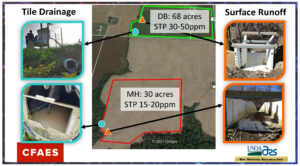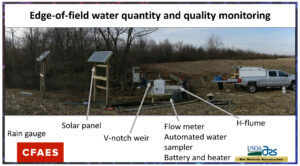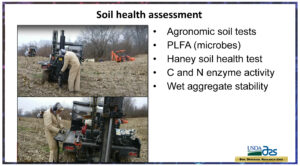Progress report for LNC20-439
Project Information
1. PROJECT SUMMARY
This project explores co-benefits of long-term soil health practices (SHPs) and their potential impacts on water quality. Long-term, continuous, and integrated SHPs (e.g. no-till+crop rotation+cover crops) build healthy soils and are important element of sustainable agroecosystems. Few studies assess the effect of improved soil health on edge-of-field (EOF) water quality, i.e. nutrient and sediment loss. Those studies that have focused on both soil health and water quality have primarily considered the short-term effects of a single SHP. However, these studied systems are in fact “transitional” and measurement likely ceases before the systems become “mature” and manifest their full potential. Our preliminary studies piloted through past SARE-funded efforts suggest that fields with transitional (3 to 10 years) to mature (40+ years) SHPs not only exhibit unique soil health indicators, but also have unique water quality signatures compared to conventionally managed systems. Through this interdisciplinary and farmer-oriented project we will compare soil health and EOF water quality on paired-fields that have different histories of integrated SHPs, specifically (1) conventionally managed (2) transitional, and (3) mature SHP systems. We will work with farmer collaborators to assess soil health and monitor EOF water discharge, concentrations of sediment, soluble and total reactive nutrients in surface and subsurface drainage. Using soil health and crop yield data we will derive a ‘relative SHP-maturity index’ for each site. The paired-field design will aid in site-specific comparisons among the treatments while controlling for spatio-temporal and climatic factors. We will conduct inter-site comparisons of water quality impacts using correlation, multivariate regression, and principal component analyses. New information will be disseminated to stakeholders through farmer-led field days, conferences, news articles, peer reviewed publications/factsheets, and social media. The long-term funding option will enable us to (1) follow the sites through multiple crop rotations, and (2) track the 'transitional' sites as they become more mature, and over a range of climatic conditions. Such extensive dataset from the long-term project would validate and increase the confidence in findings. The learning outcome of the project will be an improved understanding of the relationship between soil health and EOF water quality in transitional and mature systems. The action outcome will be enhanced adoption of long-term SHPs by growers and promotion by educators who understand the environmental impacts/benefits of long-term soil health improvements. The project outputs and outcome will benefit agroecosystems, waters, and communities in Ohio as well as the North Central region.
2. PROJECT OBJECTIVES/OUTCOMES
- Objective-1: To assess soil health at conventional, transitional, and mature soil health practice (SHP) sites.
- Objective-2: To monitor edge-of-field water quantity and quality at these sites.
- Objective-3: To determine relationships between progressive soil health improvement and water quality at individual sites and across all sites.
- Objective-4: To inform decision-makers about the soil health-agroecosystem-water quality nexus.
Learning outcome: improved understanding of the relationship between soil health and edge-of-field water quality in transitional and mature systems compared to conventional systems.
Action outcome: Clarifying the relationship between healthy soils and healthy waters will encourage broader adoption and incentivization of SHPs.
Healthy soils could potentially reduce agricultural nutrient losses by several mechanisms including more efficient nutrient- and water-use, improved water infiltration and water holding capacity, and reduced soil erosion (USDA-NRCS 2015). Conversely, nutrient loss risk could be increased by SHPs through increased concentration of nutrients, particularly in near-surface soil layers. Several studies have related soil health practice implementation to field scale nutrient losses, reporting inconsistent effects including increased P losses. There is a need for long-term research to determine how the water quality signature of SHP systems diverges over time from that of conventional systems. This project aims to fill this gap by connecting improvements over time (especially long-term) in soil health to the edge-of-field water quality impacts.
Research
We anticipate testing the following hypotheses:
(1) Soil health indicators under mature soil health practices are significantly different from those under transitional and no SHPs.
(2) Water quality signatures from fields under mature soil health practices are significantly different from those under transitional and no SHPs.
We have adopted a collaborative, interdisciplinary, inter-agency approach and identified collaborators from within OSU and the USDA-ARS who have existing edge-of-field (EOF) monitoring infrastructure that can be leveraged to broaden the scope and impact of the proposed project.
We have established monitoring at three paired-field sites (6 individual fields) across Ohio (Figure-1). Each site consists of a mature SHP system compared to a transitional and/or conventional system. The paired-field approach helps minimize the uncertainty due to local factors as well as inter-annual variability. The sites are: (1) USDA-ARS site - MM (2 fields) comparing a conventional production system to a newly transitional system and will be monitored and maintained by the USDA-ARS as part of their EOF research network. There is no farmer collaborator since this is a demonstration farm in Seneca County. (2) OSU-PPP site - DM (2 fields) comparing a mature, long-term no-till +cover crops field with a neighboring conventionally managed field. The mature field is under 30-years of no-till and 15-years of cover crops. and (3) Brandt site - DB (2 fields) comparing a mature field with a a conventionally managed field.
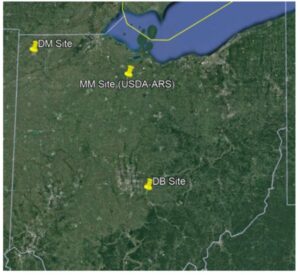
Objective 1 - Assessing soil health
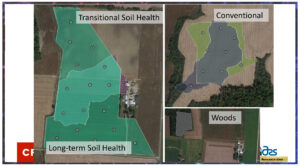
At each field site, we will determined sampling zones based on soil types, slopes, and yield histories. Standard 30 cm (12 in.) soil cores were taken in each zone with GPS-guided sampling procedure in year-1 (Fall 2020). The soil cores were then processed in laboratory, split into three depths (0-5 cm i.e. 2in., and 5-15 cm i.e. 2-6 in., and 15-30 cm, i.e. 6 to 12 in.), and sent to collaborating and external labs for soil health analysis. The list of analyses is as follows:
Soil biological indicators: Haney test, Phospholipid fatty acid (PFLA), phosphatase enzyme activity.
Soil chemical indicators: pH, electrical conductivity, soil organic matter, total organic carbon, total- and organic nitrogen, active carbon (POX-C), plant available N-P-K, base saturation, cation exchange capacity, ACE protein.
Soil physical indicators: Bulk density, aggregate stability using wet sieving,
Objective 2 - Monitoring edge-of-field water quantity & quality
A total of 4 (at Brandt site and PPP site) of the 6 fields were installed with new monitoring equipment. The remaining 2 fields (USDA-ARS site) are already instrumented. In general, the surface runoff and subsurface (tile) drainage monitoring was set up as follows: An H-flume with wing walls captures surface runoff and allows for flow measurement. The outlet of sub-surface (tile) drainage system is retrofitted with a Thelmar V-notch for flow measurement. Automated water sampling equipment (Isco 6712 water sampler, Isco Signature bubbler flow meter, and Isco 350 Area/Velocity sensor) is installed to collect water samples and measure discharge. The equipment is housed in an insulated box and powered by on-site solar panels and battery. A propane water heater enables cold-weather sampling. Precipitation is measured using an on-site tipping bucket raingauge and/or automated weather station.
Note that with the help of our shared resources, we were able to include "surface runoff monitoring" at all three paired sites. This was an improvement over the originally proposed research plan, that focused only on subsurface drainage losses.
Water Quality analysis
The automated water samplers collect 2-day composites at 6-hr time intervals during baseflow conditions and 1-hr composites at 15-minute interval during high flow conditions. We visit each site every 2 weeks for sample collection and system maintenance. The water samples from the USDA-ARS site are then analyzed in the USDA-ARS analytical laboratory using methods described in Williams et al. (2015). Samples from the Brandt and PPP sites are returned to OSU water quality laboratory and analyzed for concentrations of sediment (as needed), ammonium (NH4-N), nitrate (NO3-N), total Kjeldahl nitrogen (TKN), total N, DRP, and total P using methods similar to the USDA-ARS laboratory.
Soil Health Analysis - Preliminary Results (2021):
The results of soil health analysis and water quantity and quality observed in calendar year 2021 were summarized in Year-1 progress report (https://projects.sare.org/project-reports/lnc20-439/).
Edge-of-field water quality and quantity results (2021 and 2022):
We were able to summarize water quantity and quality data collected at the three paired sites for calendar year 2021 and 2022. The preliminary results are presented in the following figures with brief description in figure captions.
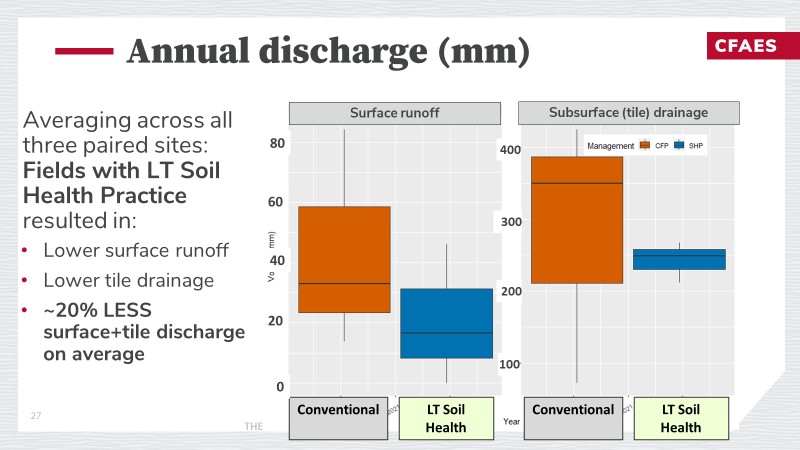
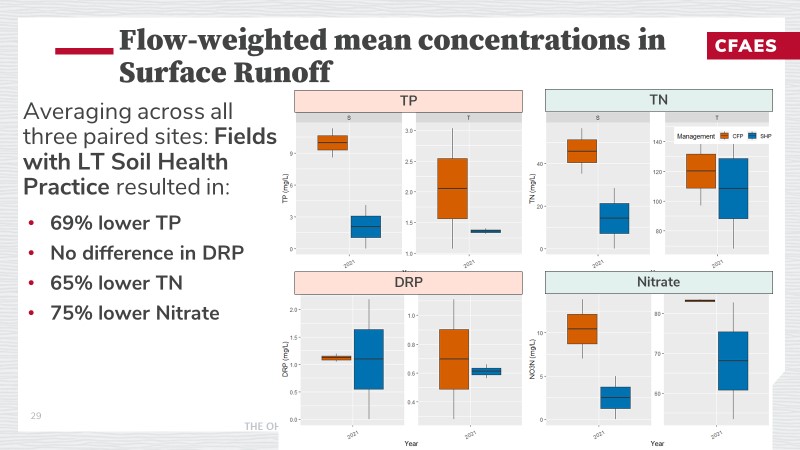
75% lower Nitrate FWMC in surface runoff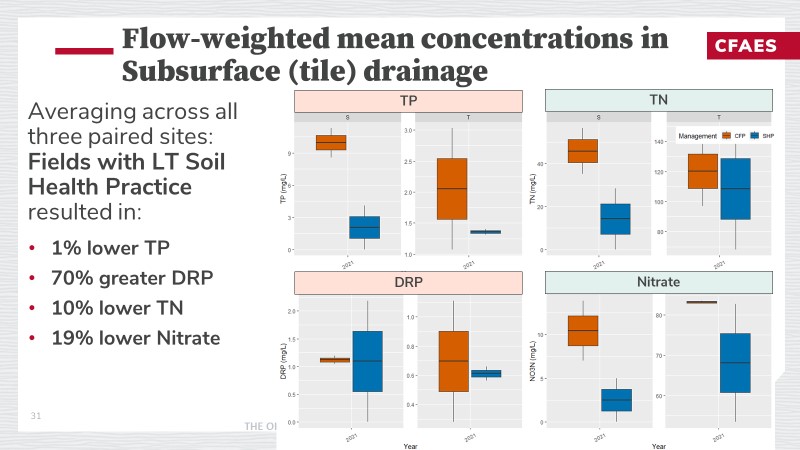
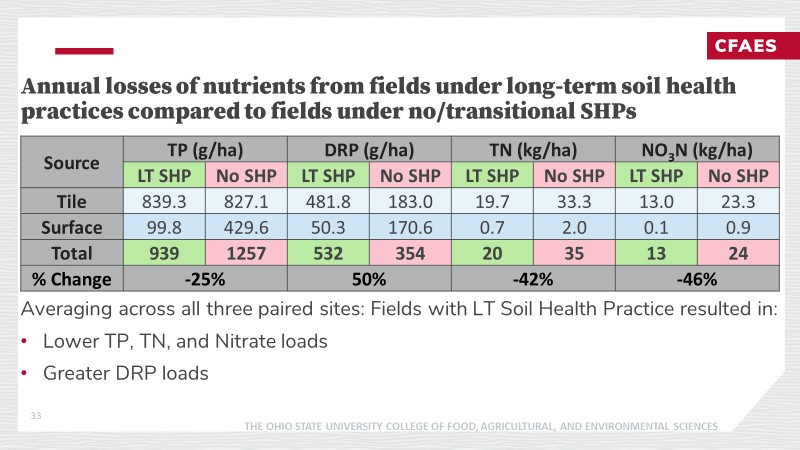
Management across three paired sites:
We have collected agronomic inputs and management data from three paired sites. Although ,we are in the process of synthesizing and analyzing these data, we have noticed significant differences in the amounts, schedules, and types of inputs and management between long-term SHP fields versus the No or Transitional SHP fields. These differences in inputs within each pair make it difficult to compare results from each individual year. However, if we are able to collect and analyze the data across multiple years that cover full crop rotation cycles, we will have the ability to compare one system versus the other.
Preliminary findings suggest that long-term soil health practices improve water quality:
- Less volume of water discharge through both tile drainage and surface runoff
- Lower concentrations and losses of nitrate
- Lower TP losses lower/greater DRP losses, despite greater concentrations in surface runoff
For conclusive evidence long-term monitoring covering two to three crop rotations is crucial
Education
- Water and Nutrient Losses from Healthy Soils under Sustainable Ag Practices. (Vinayak Shedekar). Invited talk at the Conservation Tillage and Technology Conference, Ohio Northern University, Ada, OH (March 9, 2022).
- Can long-term soil health improve water quality? (Will Osterholz). Invited talk at the Ohio No-Till Council Spring Field Day Organized at David Brandt Farm , Carroll, OH (April 8, 2022)
- Water and Nutrient Losses from Healthy Soils under Sustainable Ag Practices (Vinayak Shedekar). Presentation at the 2022 Annual International Meeting of American Society of Agricultural and Biological Engineers (ASABE), Houston, TX (July 17-20, 2022).
- Osterholz, W. 2022. “The complexcomplicated nature of soil health practices and water quality outcomes”, presented at Wisconsin Discovery Farms annual conference, Glacier Canyon Conference Center, Wisconsin Dells, WI. Dec. 14, 2022. https://uwdiscoveryfarms.org/2022/11/01/2022-discovery-farms-conference/
- Shedekar, V. 2022 Hot Topics in Soil Health – Presented at the 2022 Soil Health Webinar Series. March 3, 2022 https://youtu.be/URDmcKNB6uw?si=Cr-gqY0BIX00DKme
- Shedekar, V. and Osterholz, W. 2022. Can Long-Term Soil Health Practices Improve Water Quality? Webinar Presentation at the Iowa Learning Farms. Oct. 5, 2022. https://vimeo.com/757723396
Project Activities
Educational & Outreach Activities
Participation Summary:
Shedekar, V., Osterholz, W. 2022. Water and Nutrient Losses from Healthy Soils under Sustainable Ag Practices. Invited talk at the Conservation Tillage and Technology Conference at Ada, Ohio. (March 9, 2022). Attendees: 91
Shedekar, V. and Osterholz, W. 2023 “Soil health and water quality”, Webinar presented at 2023 Soil Health Webinar Series Organized by the Ohio State University Extension. March 30, 2023. https://youtu.be/Foy4XKWYzrA?si=3z6-InestdKw9rev Attendees: 51
Shedekar, V. and Osterholz, W. 2022 “Long-term Soil health and water quality”, Presentation at the Ohio No-Till Council Field Day at the David Brandt Farm, April 8, 2022. Attendees: 150
Shedekar, V. Brooker, M., Osterholz, W. et al. 2022. Water and nutrient losses from healthy soils under long‐term sustainable agricultural practices. Presented at the American Society of Agricultural and Biological Engineers Annual International Meeting held during July 17-20, 2022 at Houston, TX. Presentation date: July 19, 2022. Attendees: 39
Can cover crops and no-till improve soil health and water quality in Ohio? Webinar presented for the Ohio TNC Lunch & Learn Webinar Series, August 23, 2022. https://youtu.be/OjMrovVhmXs?si=P-iXjMXshUZp0_LM Attendees: 24
Shedekar, V., Osterhoz, W., Kalcic, M., King, K.W. 2022. Soil Health and Drainage Water and Nutrient Losses. Presentation at the 11th International Drainage Symposium organized during August 30-September 2, 2022 at Des Moines, Iowa. Presentation date: Sept. 1, 2022. https://www.swcs.org/events/past-events/past-specialty-conferences/ Attendees: 36
Shedekar, V. and Osterholz, W. 2022. Can Long-Term Soil Health Practices Improve Water Quality? Webinar Presentation at the Iowa Learning Farms. Oct. 5, 2022. https://vimeo.com/757723396 Attendees: 50
Shedekar, V., Osterholz W., 2022. Soil Health & Water Quality. Invited presentation at the Ohio No-Till Conference at Plain City, Ohio. Dec. 7, 2022. https://youtu.be/8IxxFC5k9H0?si=1IQCZADFFBkxU_IY Attendees: 75
Osterholz, W. 2022. “The complicated nature of soil health practices and water quality outcomes”, presented at Wisconsin Discovery Farms annual conference, Glacier Canyon Conference Center, Wisconsin Dells, WI. Dec. 14, 2022. https://uwdiscoveryfarms.org/2022/11/01/2022-discovery-farms-conference/ Attendees: 75
Additionally, we hosted at least two different groups of students and professionals at the study sites for tours/demonstrations.
Our team has been contacted multiple times for short to long conversations about the connections between soil health and water quality.
